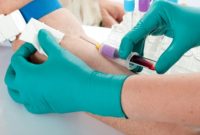Phlebotomy has an important role in the treatment of conditions like hereditary hemochromatosis, porphyria cutenea tarda (PCT) and polycythemia vera (PV). How is therapeutic phlebotomy for polycythemia vera? The explanation about it can be read below.
Therapeutic Phlebotomy for Polycythemia
As explained on the Verywell Health website, polycythemia vera is a condition where a genetic mutation causes the bone marrow to make too many red blood cells, platelets, and white blood cells. It is also explained that it increases in the blood cells, especially the red blood cells, thickens the blood which slows blood flow. If therapeutic phlebotomy is performed to remove the blood for polycythemia, it can improve symptoms and reduce the risk of developing clots
On WebMD site, it is also explained that often a phlebotomy is the first treatment for polycythemia vera. During this therapy, your doctor will remove blood from your vein and it is like donating blood. Furthermore, it is explained on that site that the purpose of it is to lower the number of your blood cells. After that, your blood will be thinner and flow better. Usually, you will feel better and some symptoms will get better such as dizziness and headaches. Your doctor will make a decision about how often you need phlebotomy and for some people, it is all they need for a lot of years.
You may wonder how often you need to get phlebotomy for polycythemia vera (PV). According to the WebMD site, you will get this treatment once a week or month until your hematocrit goes down to around 45%. It is also explained that hematocrit is the percentage of red blood cells compared with the total amount of blood. If the level of your red blood cell has dropped, you will get phlebotomy less often.

Process of Phlebotomy
Phlebotomy can be done in a hospital, physician’s office or at a blood donation center. As explained on the Verywell Health site, a needle will be put in a large blood vessel usually in the elbow crease to remove blood and your blood may be collected in a bag or in syringes. In adults, usually, blood will be removed around 450 to 500 mL at a time.
On Verywell Health site, it is also explained that for Polycythemia vera (PV), phlebotomy is done once or twice a week until the hematocrit is almost normal. After that, phlebotomy is done every few months where it is done to keep the hematocrit near normal.
Phlebotomy Side Effects
The main side effects of phlebotomy are related to the change in the volume of blood. Dizziness or low blood pressure may be experienced by you after phlebotomy is done to you. However, some people can tolerate it without any problems. After the procedure, you should drink a lot of water and if you find that the symptoms persist or it is not tolerable, saline fluid can be given to you via the IV and the function of it is to replace the volume removed.
Diagnosis of Polycythemia Vera
According to the Mayo Clinic site, doctor will take your detailed medical history and a physical exam will be performed. It is also explained on that site that if you have polycythemia vera, blood tests may reveal the things below.
- There may be more red blood cells than normal and sometimes an increase in platelets or white blood cells.
- There may be a greater percentage of red blood cells that make up total blood volume (hematocrit measurement).
- There may be elevated levels of the iron-rich protein in red blood cells that brings oxygen (hemoglobin).
Let’s say that your doctor suspects that you have polycythemia vera. If so, your doctor may recommend collecting a sample of your bone marrow through a bone marrow aspiration or biopsy. As explained on the Mayo Clinic site, in bone marrow biopsy, it involves taking a sample of solid bone marrow material and usually, a bone marrow aspiration is done at the same time. It is also explained that during an aspiration, a sample of the liquid portion of your marrow will be withdrawn by your doctor.
Treatment for Polycythemia Vera
According to the Mayo Clinic site, there is no cure for polycythemia vera. However, there are treatments which focus on decreasing your risk of complications. Your symptoms will also be relieved by these treatments. Those treatments are listed below as explained on Mayo Clinic site.
- Blood Withdrawals
Having frequent blood withdrawals, using a needle in a vein or phlebotomy is the most common treatment for polycythemia vera as explained on Mayo Clinic. It can decrease the volume of your blood and it can decrease the number of excess blood cells. If you wonder how often you must have blood drawn, it depends on the severity of your condition. - Treatments to Reduce Itching
Do you have bothersome itching? If so, as explained on Mayo Clinic site, your doctor may prescribe medication like antihistamines or recommend ultraviolet light treatment so that it can relieve your discomfort. - Drugs For Reducing the Number of Red Blood Cells
If you find that phlebotomy does not help enough, your doctor may give you medications which can reduce the number of red blood cells in your bloodstream such as Interferon alfa-2b (Intron A), Hydroxyruea (Droxia, Hydrea), Busulfan (Busulfan, Myleran), and Ruxolitinib (Jakafi). - Heart Medications
You may also be prescribed medications by your doctor to control risk factors for heart and blood vessel disease, including diabetes, high blood pressure, and abnormal cholesterol. Besides, you may also be recommended by your doctor to take a low dose of aspirin to reduce the risk of blood clots. A low dose of aspirin may be able to help reduce burning pain in your feet or hands.
Lifestyle for You Who Have Polycythemia Vera
As explained on the Mayo Clinic site, you can try the things below to help yourself feel better.
- You are able to do moderate exercise like walking.
- You have to avoid tobacco.
- You have to avoid low-oxygen environments.
- You have to be good to your skin. You can bathe in cool water, use a gentle cleanser and pat your skin dry. It is done to reduce itching.
- You have to avoid extreme temperatures.
- You have to watch for sores.






